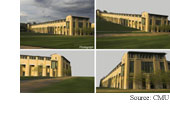|
NEWS
|
3D from 2D
 A
computer vision system estimates
the three-dimensional geometry of a scene from a two-dimensional
image and detects objects within the scene. The technique
could help robots and other computer systems identify
buildings, roads, vehicles and people in street scenes
using information from ordinary cameras. (Putting Objects
in Perspective, IEEE Computer Society Conference on Computer
Vision and Pattern Recognition, New York, NY, June 17-22,
2006) A
computer vision system estimates
the three-dimensional geometry of a scene from a two-dimensional
image and detects objects within the scene. The technique
could help robots and other computer systems identify
buildings, roads, vehicles and people in street scenes
using information from ordinary cameras. (Putting Objects
in Perspective, IEEE Computer Society Conference on Computer
Vision and Pattern Recognition, New York, NY, June 17-22,
2006)
Beastly blend
A blend of proteins
from microscopic sea creatures and spiders yields
a material with the flexibility and strength of spider
silk and the durability and nanostructure of diatom shells.
The chimeric protein can be used -- in a relatively simple,
clean process -- to make many types of materials, including
fibers and films that could be used for generating bone
tissue. A (Novel Nanocomposites from Spider Silk-Silica
Fusion (Chimeric) Proteins, Proceedings of the National
Academy of Sciences (PNAS), June 13, 2006)
Naturally waterproof
Three different projects (1,
2,
3)
have copied nature to produce superhydrophobic surfaces
that mimick the wing of a desert beetle and the structure
of plant leaves. The surfaces could be used to make waterproof
coatings, water collection systems and labs-on-a-chip.
(Patterned Superhydrophobic Surfaces: toward a Synthetic
Mimic of the Namib Desert Beetle, Nano Letters, June 14,
2006; Mass-producible Replication of Highly Hydrophobic
Surfaces from Plant Leaves, Nanotechnology, July 14, 2006;
Super-Hydrophobic Surfaces from a Simple Coating Method:
a Bionic Nanoengineering Approach, Nanotechnology,
July 14, 2006)
Sturdier DNA
The DNA molecule, renowned for its self-assembly
abilities, can be used to make nanotubes, but the tiny
structures break down in water, on surfaces and at moderate
temperatures. A process of patching
nicks in the nanotubes with small pieces of DNA make
tubes much sturdier, paving the way for their use in drug
delivery, nanowire templating and other applications.
(Sturdier DNA Nanotubes via Ligation, Nano Letters,
published online June 20, 2006)
Electric DNA scanner
A method of measuring
voltage changes as a strand of DNA passes through
a 1-nanometer-diameter hole allows individual bases in
the molecule to be distinguished electrically. The technique
could be used to make labs-on-a-chip capable of spotting
the smallest of genetic mutations, many of which are implicated
in diseases. (Electrical Signatures of Single-stranded
DNA with Single Base Mutations in a Nanopore Capacitor,
Nanotechnology, July 14 2006)
Broadband optical chips
A silicon
amplifier that powers optical signals across a relatively
wide range of wavelengths is a boost for all-optical communications
chips. All-optical chips that simultaneously process multiple
communications channels promise to lower the cost and
increase the speed of communications networks. (Broad-band
Optical Parametric Gain on a Silicon Photonic Chip, Nature,
June 22, 2006) |
FEATURES
|
View
from the High Ground: ICL's John Pendry
Physics as machine tool, negative refractive
index, metamaterials, shattered wine glasses, higher capacity
DVDs, scientific backwaters, risk perception and practice,
practice, practice.
|
How
It Works: Quantum computing: qubits
Photons, electrons and atoms, oh my! These particles are
the raw materials for qubits, the basic building blocks
of quantum computers. |
|
 |
News RSS feed 
Blog RSS feed 
Bookshelf RSS feed

New: TRN's
Internet Services
TRN's Jobs Center
|
| |
|
| |
|
| |
"Physics
is to the rest of science what machine tools are
to engineering. A corollary is that science places
power in our hands which can be used for good or
ill. Technology has been abused in this way throughout
the ages from gunpowder to atomic bombs."
- John Pendry, Imperial College London |
|
| |
|
| |
Thanks
to Kevin from
GoldBamboo.com
for technical support |
|

